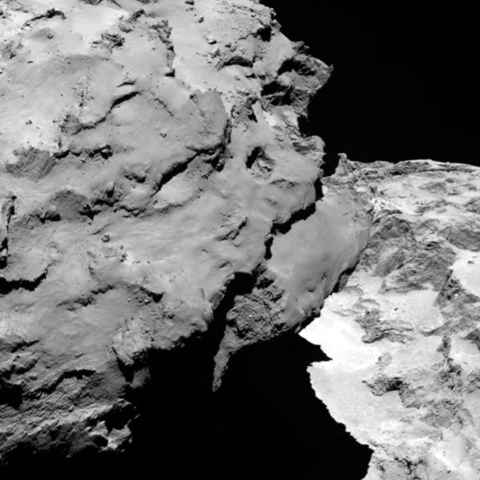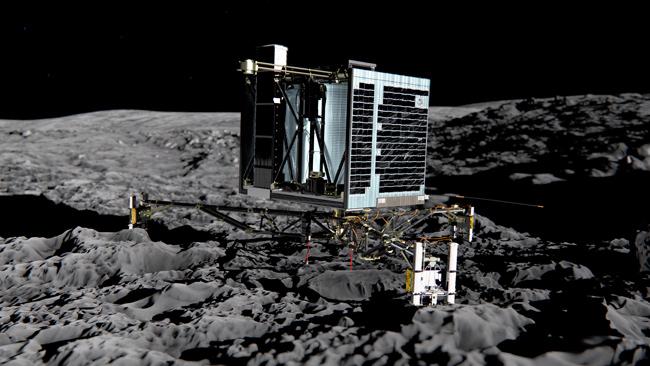
On the 6th of August 2014, after a number of extremely accurate manœuvres, Rosetta and its small lander Philae has joined up with comet 67P/Churyumov-Gerasimenko at a point in the solar system which is 405 million km from the Earth and 540 million km from the Sun, between the orbits of Mars and Jupiter. Together, they are now heading for the Sun at a speed of 55 000 km/hour !
Strictly speaking, the probe is not in orbit around 67/P but is following the comet in its heliocentric orbit, while executing parts of hyperbolic orbits so as to map the nucleus and better understand its gravitational field.
This is the first time in the history of the exploration of the solar system that an interplanetary probe will follow a comet for many months and study how its activity changes as it approaches the Sun, as well as landing on its surface.
The first pictures sent by the OSIRIS instrument have shown that the shape of the nucleus is rather more complex than was foreseen, and that as early as June, when the probe was still at a distance of about 30000 km. The nucleus seems to be « binary », i.e. made up of two blocks linked by a bridge of matter.
The high resolution images acquired by Osiris during just the last few days are incredibly full of detail ; researchers now have new kinds of terrain to study, as well as the puzzle of the shape of the nucleus : in effect, the matter bridge seems to be much brighter than the two parts of the nucleus : this suggests the presence of a significant quantity of ice which could sublimate each time that the comet comes close to the Sun. Thus, the narrowing of the central part of the nucleus could be just a process of gradual erosion.


The Rosetta mission involves over 300 European scientists, including many French teams. Overall, 80 Franch scientists took part in the development of the instruments for the pobe and for the lander ; they will now analyse the data being acquired.
The instrumental contribution of the Paris observatory
Scientific teams at the Paris Observatory have participated in the design and realizaton of three of the eleven instruments on the orbiter.
MIRO (Microwave Instrument for the Rosetta Orbiter)
This spectrometer was designed not only to measure the sub-surface temperature of the cometary nucleus, but also to find its composition through a study of the volatile ejecta, and also to unerstand the mecanisms responsible for its activity (the process of sublimation and the creation of the gas and dust in the coma).
It provides very high resolution spectral data in the millimetre and submillimetre wavelength range, and studies the spectral signature of a number of important gaseous components : water vapour, carbon monoxide, ammonia, methanol. The purpose of MIRO is to determine the abundances of each of these components in order to understand the nature of the cometary nucleus, the degassing process, and where it occurs on the cometary surface.
The engineers (A. Deschamps, M. Gheudin, J.-M. Krieg) of the Laboratoire d’études du rayonnement et de la matière en astrophysique et atmosphères (laboratory for the study of radiation and astrophysical matter) - LERMA (Paris Observatory / CNRS / Univ. Cergy-Pontoise / UPMC / ENS) and Laboratoire d’études spatiales et d’instrumentation en astrophysique (laboratory for space studies and astrophysical instrumentation) - LESIA (Paris Observatory / CNRS / UPMC / Univ. Paris-Diderot) helped to furnish this instrument together with the Jet Propulsion Laboratory in California and the Lindau Max-Planck Institute in Germany.
VIRTIS (Visible and Infrared Thermal Imaging Spectrometer)
This near infrared spectro-imager consists of a low resolution spectro-imager channel VIRTIS-M and a high spectral resolution channel VIRTIS-H. The development of the VIRTIS instrument was led by the Rome Istituto di Astrofisica e Planetologia Spaziali (IAPS/INAF), in collaboration with the German space agency DLR, and the Laboratoire d’Etudes Spatiales et d’Instrumentation en Astrophysique - LESIA of the Observatoire de Paris. The high resolution channel VIRTIS-H was completely designed, built and tested at the LESIA (X. Bonnin, M. Bouyé, O. Dupuis, A. Fave, Y. Ghomchi, Y. Hello, F. Henry, G. Huntzinger, S. Jacquinod, D. Kouach, J. Parisot, A. Piacentino, J.-M. Reess, A. Sémery, D. Stephanovitch)


Its main scientific objectives are to measure thesurface temperature of the cometary nucleus, to determine the chemical composition of this surface and to estimate the superficial distribution of the various compounds, to assess the various volatiles (CO2, etc) in the coma, and to get a better understanding of the process of gas and dust ejection.
OSIRIS
The OSIRIS NAC (Narrow-angle camera) and the WAC (Wide Angle Camera) will acquire images of the surface and also the coma of comet Churyumov-Gerasimenko in the visible domain using various filters.
The Laboratoire d’études spatiales et d’instrumentation en astrophysique (laboratory for space instrumentation and astrophysics) – LESIA of the Paris Observatory has taken part in the design of the OSIRIS-NAC (OSIRIS narrow-angle camera) instrument, under the scientific leadership of theMarseille Laboratoire d’Astrophysique , together with the LATMOS (CNRS/UPMC/UVSQ). The very high resolution images are already being downloaded daily to Earth, and are revealing an incredible richness of detail and geological diversity, which scientists are beginning to study.
The scientific analysis of the data
The instruments are now fully operational ; ; scientists at the Paris Observatory are ready to start analysing the data.
Rosetta has now started to make a complete mapping of the nucleus, using its various instruments, and in particular the OSIRIS camera, the infrared spectro-imager VIRTIS and the radiometer MIRO.
From its orbit, with an altitude varying from 100 to 30 km, OSIRIS will acquire not only detailed images of sthe surface, but also of the coma and the jets which emerge from the surface. VIRTIS willl map the nucleus at various wavelengths (from 0,25 to 5 microns) in order to obtain not only the chemical composition, but also the temperature of the nucleus. MIRO itself will measure the temperature below the surface at various depths, as well as the speed of ejection of water molecusles in the coma.
LESIA scientists (D. Bockelée-Morvan, N. Biver, C. Leyrat, E. Lellouch, T. Encrenaz, J. Crovisier, W. Yvart) as well as those from the LERMA (G. Beaudin) participate in the analysis and in the interpretation of the MIRO data. Their work has helped in the estimation the rate at which the comet produces water which, to date, corresponds to the equivalent of three glasses of water per second.
Their work has also helped to elucidate the chemical composition of the superficial ometary material, the internal structure and composition of the nucleus, the dynamics and the kinds of dust being emitted, the surface degassing, magnetism , etc.
Furthermore, they have the entire scientific responsibility for the VIRTIS-H instrument, i.e. for the high resolution channel of VIRTIS. They are deeply involved in the preparation of observations using the VIRTIS spectro-imager, as well as the corresponding scientific interpretation (S. Erard, D. Bockelée-Morvan, C. Leyrat, P. Drossart, A. Barucci, M. Combes, J. Crovisier, D. Tiphène, N. Biver, V. Debout, D. Despan, S. Fornasier, F. Merlin).
Moreover, the LESIA engineers (F. Henry, S. Jacquinod, J.-M. Reess) manage the telecommands and the high resolution operations, calibrate the data in physical units, and calculate the orbital data required for the physical interpretation.

During the next few months, the shape, the dynamics, the gravitational field of the nucleus will be analyzed in detail, as well as the composition of the ejecta of the nucleus.
From September on, the probe will approach the nucleus gradually, from an almost circular orbit close to the terminaor, in order to reduce the pressure of gases acting on the solar panels, whose total surface exceeds 64 m2.
5 possible landing sites for the « Philae » lander will be chosen, based in part on their scientific interest, through the analysis of the data by the co-Is (the co-investigators) of the instruments, but especially on technical criteria furnished by the European Space Agency’s ESOC « flight Dynamics » in Darmstadt, together with the SONC (Science Operations Center) in Toulouse.
These sites will have to be compatible with specific constraints : accessibility from Rosetta’s orbit, low surface activity, relatively smooth surface, at least 6 hours of light per day so that Philae can rechage its batteries, etc).
2 sites will then be selected in the second phase. A few weeks before the landing, programmed for November 11 2014, the probe will inject itself into an elliptical 5x10 km orbit if cometary activity is weak, or into a slightly larger orbit if this activity is considered too risky for the probe. The site where Philae will finally land will be chosen at this stage.
While the safety of the probe and the engineering criteria are uppermost at this stage of the selection process, the scientists’ opinionswill however have considerable weight. For example, data furnished by VIRTIS will lead not only to a map of the surface composition, but will also enable one to identify zones where the surface is porous or not. Each team will thus furnish information helping to identify scientifically interesting zones.
Landing will take place on November 11th, and Philae will be released from an altitude which depends on the cometary activity, onto a billistic trajectory which can no longer be changed Once on the surface, its batteries will allow it to function for two to three days.
Once this has been done, the energy source will be switched to a second set of batteries running off the solar panels, so that the various experiments can work for several months.
The orbiter itself will continue to study the nucleus and its environment as the comet approaches the Sun (closest passage in August 2015), until at least December 2015 . The adventure is just starting !

